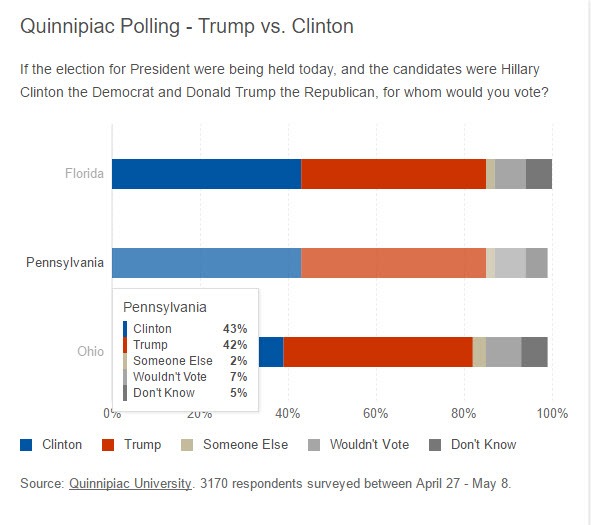
Bernie Sanders has proven to be a true thorn in Hillary Clinton‘s side, and many have wondered why he won’t give up the race. There’s actually some good reasons why Vermont Sen. Sanders is holding on tighter than a Kardashian to a killer publicity opportunity. In a recent poll, it shows that he actually has a much stronger chance of going up against Donald Trump in the 2016 Presidential Election than Hillary Clinton. It will be interesting to see if she winds up getting him as her running mate as it would make sense for her to wipe out Trump rather easily.
In a general election matchup, Vermont Sen. Bernie Sanders topples Donald Trump by twice as much as Hillary Clinton, according to polling data from RealClearPolitics. While this doesn’t seal the deal for a Sanders victory — a lot can and will happen in the six months between now and November — it certainly buoys Sanders’ assertion that he should remain in the race.
On the Republican side, the field narrowed for a decisive, final time last week as Texas Sen. Ted Cruz and Ohio Gov. John Kasich dropped out after Trump won the Indiana primary. Trump remains shy of the necessary 1,237 delegates needed for the nomination, but the lack of active competitors means the businessman-turned-reality-TV-star is the presumptive Republican nominee.
With a tumultuous GOP primary in the rearview mirror, our friends at Inside Gov turns to general election matchups to see how Trump fares against each of his potential Democratic foes.
Trump vs. Clinton
In a December 2015 “Saturday Night Live” skit that saw the return of Amy Poehler and Tina Fey, the comedy writers called a runaway win for Clinton against Trump. But a look at polling data paints a different picture.
As of May 9, Clinton holds about a six-point lead over Trump in a general election contest. As the visualization shows, the former secretary of state has maintained an advantage over Trump throughout the campaign, with the gap beginning to widen in mid-March.
On March 15, both Clinton and Trump scored big wins on Super Tuesday II, which might explain the shift. Although there have been many ups and downs in the race, that was a critical moment because it was one of the first times either Clinton or Trump truly proved their frontrunner status. Clinton swept the board while Trump lost only one primary. In the process, Trump knocked out Florida Sen. Marco Rubio, who suffered a deflating loss in his home state and had been seen as one of the GOP’s best options to fend off Trump.
In some ways, that was the first instance a Clinton-Trump race looked like a real possibility. And since then, Clinton has maintained her lead, according to the polling data.
But the news isn’t all good for Clinton’s camp. A recent poll from Quinnipiac University shows tight races brewing between Clinton and Trump in the key battleground states of Florida, Pennsylvania and Ohio.
As the visualization shows, Clinton clings to a one-point lead in Florida and Pennsylvania. She is down by four in Ohio. The margin of error in all three surveys is plus or minus 3 percentage points, meaning that these razor-thin differences are around this range.
Bottom line: These states are in tossup territory right now.
Trump vs. Sanders
Despite being far behind Clinton in the delegate race, Sanders continues to pledge to stay in the Democratic nomination contest until the final primary in June. While that has frustrated the Clinton campaign, general election polling indicates Sanders has a better shot than Clinton at beating Trump come November.
While Clinton currently has a 6.4-point lead over Trump, Sanders doubles that, according to polling data. As of May 9, Sanders is up by 13 points against Trump.
As was the case with Clinton, Sanders’ lead widened in mid-March when Trump’s string of decisive primary wins suggested he was on his way to nabbing the Republican nomination. Since those victories, Trump has hovered at or below 40 percent against both Clinton and Sanders.
Sanders often reminds his supporters that polling data points to him beating Trump by a larger margin than Clinton. And, in the recent Quinnipiac poll on swing states, Sanders beats Trump by two points in Florida and Ohio, and by six points in Pennsylvania.
That same Quinnipiac poll also asked voters in each state about how they view the three remaining presidential candidates. In more good news for the Sanders camp, the Vermont senator was the only person who is viewed more favorably than unfavorably in all three battleground states. In Pennsylvania, Sanders has his highest score — a 50 percent favorability rating. In Florida and Ohio, 43 percent and 45 percent have a positive view of him, respectively.
Clinton and Trump, on the other hand, are viewed unfavorably by the majority of voters in the three states polled. Clinton’s unfavorable score hits a high of 62 percent in Ohio while Trump’s top out at 57 percent in Florida and Ohio. In addition, voters seem to have made up their minds about those two candidates. In Ohio, for example, only 2 percent of voters said they haven’t heard enough about Clinton to decide if they viewed her positively or negatively. Trump’s numbers for that question were also in the low single digits.
There’s more wiggle room for Sanders, though. Between 12 and 14 percent of voters in those states said they hadn’t heard enough about Sanders to make an assessment.
These are good numbers for Sanders, but one figure continues to trip up his campaign: 2,383. That’s the number of delegates needed to secure the Democratic nomination. Even after wins in Indiana and West Virginia, Sanders remains far behind Clinton in the delegate count.
Delegate math continues to be a significant hurdle for Sanders. There are a total of 1,065 more Democratic delegates up for grabs in the primary process. He would need to win all but 115 to capture the nomination. The Kentucky and Oregon primaries take place on Tuesday.


